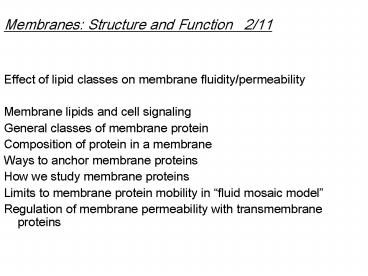Membranes: Structure and Function 211 PowerPoint PPT Presentation
1 / 16
Title: Membranes: Structure and Function 211
1
Membranes Structure and Function 2/11
- Effect of lipid classes on membrane
fluidity/permeability - Membrane lipids and cell signaling
- General classes of membrane protein
- Composition of protein in a membrane
- Ways to anchor membrane proteins
- How we study membrane proteins
- Limits to membrane protein mobility in fluid
mosaic model - Regulation of membrane permeability with
transmembrane proteins
2
Permeability is a function of solute and membrane
characteristics!
- How would these solute characteristics alter
permeability of the solute? - Solute Size?
- Solute Charge?
- Solute Gradient?
- Environmental Temperature?
3
- How would these membrane characteristics
- alter permeability?
- FA -CHCH- bonds
- 2) FA chain length
- 3) Presence of Cholesterol
- 4) PL Density
4
Cholesterol can decrease membrane permeability to
H2O and Na by filling pockets (cavities) created
by cis -CHCH- bonds in PL fatty acid chains, and
INCREASE the fluidity of the middle of the plasma
membrane. Paradoxically it can also DECREASE
membrane fluidity because the rings structure has
less flex than a single hydrocarbon chain of a
FA..
5
Carbohydrate moieties can also attached to the
lipids of the PL bilayer Glycolipids (via
sphingosine without Pi) and GPI
(glycophosphatidyl inositol)
Sphingosine is base for carbohydrates and FA Tail
6
ABO Blood typing how do you know what
erythrocytes are yours and which should be
destroyed? Larger slightly different
polysaccharide moieties determine erythrocyte
half life.
7
Why do we take Ibuprophen at the level of a
plasma membrane?Some cells cleave specific
lipids and use PL to generate hormones and other
extra/intracellular signals. The formation of
arachidonic acid (a committed step) is a classic
for inflammation!
8
Proteins often have carbohydrates attached for
use in 1) Cell-cell recognition, 2) Receptor
sites, and 3) Protection! This is VERY important
physiologically and pathologically.
- There are two types of carbohydrate-protein
linkage O-linked or N-linked - N-asparagine O-usually Serine or Threonine
- Polysaccharides linked by glycosidic
bonds!(R-O-R) - Saccharides can form single or branched chains!
- Classic Functions
- Function in major histocompatability complexes
- Role related to cancer treatment
- Function of glycocalyx lining gut and
endothelium - Function for bacteria causing urinary tract
infections - Function for parasitic infection
9
How are carbohydrates attached to trans-,
intergral or peripherally located
proteins?Glycoproteins typically use either O-
or N-linkages with either Straight or Branched
Sugar Chains
10
Why are glycoproteins important if you are HIV
positive?
- Structure of HIV gp120 envelope glycoprotein in
complex with the CD4 receptor and a neutralizing
antibody - http//employees.csbsju.edu/hjakubowski/Jmol/HIV_g
lycoprotein/HIVC2AD_glycoprotein.htm
11
FIGURE 15 Freeze-fracture micrograph showing an
RBC ghost membrane (G) adherent to a WGA-coated
schistosomulum (S) after 3 h of incubation. The
protoplasmic faces of the tegumental membranes
are seen with the fracture plane passing
generally through the intramembrane particle-poor
outer membrane (P2) and occasionally exposing the
intramembrane particle-rich inner membrane (P1).
No alterations are seen in the area where the
ghost is attached. The fracture was performed
under mild etching conditions, s, spines p,
pits. x 22,000.(Caulfield and Cianci . JCB. 1985
101 158.
12
How do we IDENTIFY the classes of protein one
finds associated with the plasma membrane based
on their amino acid sequence? Remember that not
ALL membrane proteins may be free to diffuse
about the membrane, some may be anchored to a
particular place.
13
We often study proteins by indirectly looking at
the DNA they were transcribed/translated from.
This is cheaper and easier than direct protein
sequencing!
14
- How do hydropathy analysis of a DNA sequence help
us predict protein functions? - Why is this useful?
- Human Genome Project and our proteins/diseases!
15
How do cells limit membrane protein mobility?
- Typical cell fusion results
- Additional evidence for the Fluid Mosaic Model
- Tags fluorescent antibodies
- Why must protein mobility sometimes be limited to
a specific location? - Gap Junctions
- Enterokinase
- Na/Glucose co-transporter
- Aquaporin
- Does this apply to prokaryotes? Why/WhyNot?
16
Are all the proteins associated with the PM
floating freely about the PM? Certainly Not!
Some proteins HAVE to be anchored in the
cytosolic side to certain locations by the
proteins actin, ankyrin, and spectrin!

